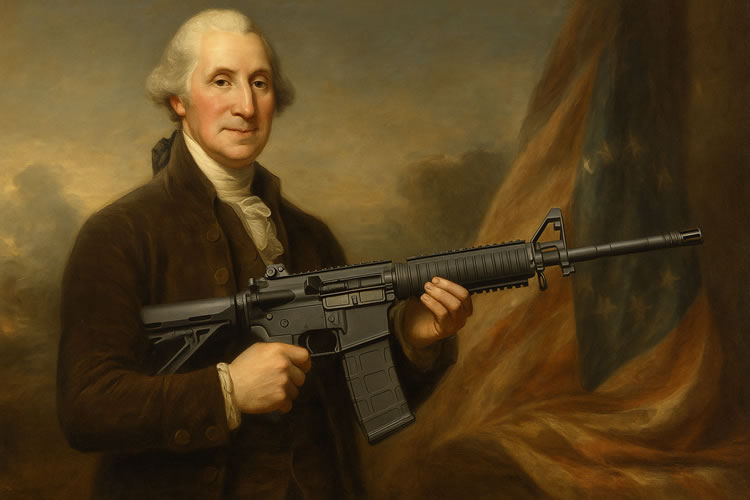Modern gun control debates often turn on a familiar refrain: “The Founders never imagined today’s firearms.” The claim suggests the men who wrote the Second Amendment pictured little more than muskets for hunting deer, not semiautomatic rifles. Yet history tells a different story. From the Revolution forward, American civilians had access to weapons that were unquestionably “weapons of war.” The Founders had lived through mass carnage on their own soil. They didn’t need to imagine. They had seen it.
Early Repeaters Pre-2nd Amendment
Long before the Revolution, inventors were experimenting with firearms that could fire multiple shots without reloading.
- Kalthoff Repeater (1620s–1650s): European design with reservoirs for powder and ball, capable of up to 30 shots before reloading.
- Lorenzoni System (1640s, Italy): Flintlock with powder and ball magazines built into the stock.
- Cookson Repeater (1720s–1730s, England): Flintlock rifle with dual magazines in the buttstock, holding 7–9 shots.
- Girandoni Air Rifle (~1780s, Austria): 20-round repeating air rifle adopted by the Austrian army; Lewis and Clark carried one on their 1804 expedition.
These weren’t curiosities. They were known to armies, collectors, and occasionally colonists. The technology existed decades before 1791, when the Second Amendment was ratified.
The Arms of 1776
For the average settler, a flintlock musket or rifle was an everyday tool. Muskets like the British Brown Bess or French Charleville were standard infantry arms. Rifles such as the Pennsylvania long rifle brought accuracy at longer ranges, though with slower reloads. Pistols, swords, bayonets, and tomahawks rounded out personal arsenals.
Heavier firepower was not limited to governments. Private citizens owned cannons, militias supplied their own artillery, and Congress issued letters of marque authorizing privateers — civilian ships with multiple cannons — to wage war at sea. Gunpowder was sold by the keg, with restrictions tied only to fire safety in crowded towns. In short, the line between “military” and “civilian” arms did not exist.
The Civil War and the Rise of Repeaters
That blurred line continued well into the 19th century. During the Civil War, Union and Confederate fighters brought personally owned rifles and artillery to the battlefield. Civilians sold repeating arms such as the Henry rifle — a lever-action weapon that fired multiple shots before reloading. By the 1860s, faster-firing weapons were no longer experimental; they were in use.
Richard Gatling patented his multi-barreled, hand-cranked “Gatling gun” in 1862, a clear forerunner of machine guns. The idea that firearms might one day fire continuously or at high rates of speed was already a reality. Meanwhile, Alfred Nobel’s invention of dynamite in 1867 gave civilians easy access to explosives. Farmers, miners, and railroad crews bought it freely. By any standard of destructive capacity, civilians had abundant “weapons of war.”
🍁 Make a One-Time Contribution — Stand Up for Accountability in Vermont 🍁
Federal Regulation Arrives Late
For most of U.S. history, there was no federal restriction on owning heavy arms. The first major law was the National Firearms Act of 1934, requiring registration and taxes on machine guns, short-barreled shotguns, grenades, and artillery pieces. It wasn’t a ban, but it made ownership expensive and tightly monitored. Antique cannons and muzzleloaders remain legal to this day. Modern artillery or explosives can still be owned with ATF approval and taxes — technically possible, though rare.
Did the Founders “Not Imagine” Modern Arms?
The claim that the Founders could not have imagined modern firearms collapses under scrutiny. These were men who had just fought a brutal war against the world’s most powerful army. They saw cannons shred regiments and powder kegs level buildings. They knew destruction firsthand.
By the mid-1800s, repeating rifles and early machine guns were already in civilian hands. By the early 20th century, dynamite was sold by the crate. The idea that civilians could not or should not access powerful arms is a modern invention. The Second Amendment was written in a world where “weapons of war” were exactly what citizens were expected to keep.
Conclusion
Critics often point to school shootings as proof that modern firearms are uniquely dangerous. History shows otherwise. The deadliest school attack in U.S. history came in 1927 in Bath Township, Michigan, when a disgruntled school board member used explosives to blow up a school, killing 45 people. Mass harm required no semiautomatic rifle — only determination and the tools at hand.
The broader lesson is often overlooked. The Founders did not live in a world innocent of “weapons of war.” They had muskets and rifles at home, cannons on their land, privateers at sea, and powder kegs powerful enough to destroy buildings. They had already seen mass death. What they also had — and what modern society too often neglects — was an expectation of accountability. Rights were assumed to carry responsibility, and misuse brought swift punishment.
Today the debate fixates on the weapons themselves. But when the Second Amendment was framed, the understanding was clear: citizens would keep arms equal to the military, and they would be held to account if they abused that right. The Founders knew exactly what “weapons of war” meant. They also knew that freedom without accountability is no freedom at all.
Dave Soulia | FYIVT
You can find FYIVT on YouTube | X(Twitter) | Facebook | Instagram
#fyivt #SecondAmendment #WeaponsOfWar #AmericanHistory
Support Us for as Little as $5 – Get In The Fight!!
Make a Big Impact with $25/month—Become a Premium Supporter!
Join the Top Tier of Supporters with $50/month—Become a SUPER Supporter!









Leave a Reply to Robert FireovidCancel reply